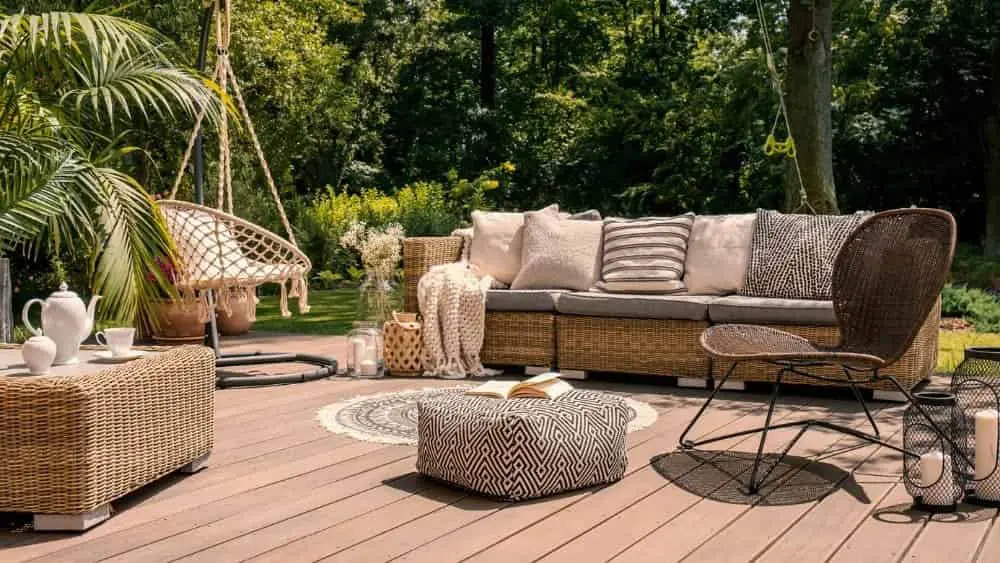
Do you dream of holding summer backyard cookouts on your new home’s spacious deck?
Or do you picture yourself sitting under the stars next to your firepit on a chilly evening?
Perhaps you’d rather spend a spring afternoon curled up reading the latest bestseller under your deck’s pergola.
Well, what are you waiting for? It’s time to build that dream deck. Here are a few things to consider before you get started:
Budget
Your No. 1 consideration is your budget. Without knowing how much you can spend, you won’t get very far, especially if you want to hire a contractor. Even if you go the DIY route, you need to set a budget for building materials. Otherwise, you may get tempted to keep adding features as you go — and end up spending way more than you intended.
Layout and Size
You should determine where you want the deck to go — off the back of the house or to the side — and whether it will be off the ground (if so, how tall) or at grade (ground level). Dan Nelson, the principal architect with Seattle-based Designs Northwest Architects, works closely with clients to help answer those questions. “Once I know what the site looks like, I do a lot of sketching to develop a site plan.”
Purpose
Going hand in hand with layout and size is the purpose of the space. How do you plan to use the deck? Do you plan to do a lot of entertaining with family and friends? If so, how many people do you need to accommodate with seating areas? Or will the space be primarily a family hangout, maybe with a kids’ play area? Do you have a fancy grill that needs to take center stage? Do you want an outdoor planter garden?
Materials
As your dream deck starts taking shape on paper, you need to consider what building materials you want to use. The three main categories are wood, composite and cellular PVC.
“We do a lot of wood and composite decks,” Nelson said. “Among the hardwoods, ipe is popular and it needs little upkeep.” Taking geography into account, he added that in the Pacific Northwest, cedar is a good choice because it’s resistant to water.
While hardwood is beautiful, it can bring with it the dreaded maintenance and upkeep, depending on the type of wood you use and the climate where you live. Wood decks can deteriorate more rapidly, causing splintering or splitting, if not properly stained on a regular basis. Wood also can attract various pests, depending on locale. One alternative is to choose a pressure-treated wood, which can provide greater durability and resistance to insects.
Composite decking is a blend of hardwood and polyethylene plastic and offers a low maintenance option for your deck. “The needs of homeowners have grown to where they have higher demands on their decks, which serve as outdoor rooms with kitchens, entertainment centers and party areas. Deck materials must perform to this increased usage and daily wear and tear,” said Carey Walley, vice president, marketing, with TimberTech and AZEK Building Products, leading manufacturer of alternative decking materials.
Composites offer a natural, authentic wood look in a variety of styles and colors and are long-lasting and durable in a variety of different weather conditions. Wood-free cellular PVCs, which are relatively new on the scene, can be a more expensive option initially, but the material more than makes up for the added cost in low maintenance and durability.
Amenities
Now that you’ve thought about your decking material, it’s time to revisit how you want to use your deck. You have a multitude of optional features and amenities to choose from beyond just adding a table and umbrella and a few chairs. The amenities you choose can combine both the practical and the esthetic, such as seating and storage options or planters to show off your green thumb.
Of greatest importance, depending on the layout, size and height of your deck, is a safety railing. Beyond the practical aspect, railings can also enhance the design and look of your deck. You don’t have to use the same material as your deck surface either. Mix it up with a wood deck and composite railings or vice versa. Or put a modern twist on the design with galvanized metal railings.
You could also add an awning, pergola, gazebo or some other cover if you don’t have a lot of natural shade. Do you need screens for a sliding door or French doors leading to your deck? Think about lighting options for evening entertaining. Consider adding a firepit or an outdoor cooking area as a step up from the standard grill (unless you have a super-fancy grill that you want to show off and get plenty of use out of). For a firepit or cooking feature, you may want to consider surrounding the area with tile or concrete for safety if you’re using natural wood decking.
Finding a Contractor
If you are confident enough in your carpentry skills to tackle installing a deck on your own, then you may be ready to head down to the local home improvement store. Otherwise, it’s time to find a contractor or architect to work with.
Start by asking your friends and family for a recommendation of a contractor they trust. Most decking manufacturers offer a way to search online for a licensed contractor as well as plenty of resources to help in designing your deck. For example, TimberTech offers a “Straight Talk” forum for consumers on its website to help answer homeowners’ questions about building and designing a deck.
“It is our desire that every customer is able to make an educated purchasing decision, whether they end up buying TimberTech or not,” said Walley. The North American Deck and Railing Association also provides a listing of deck builders by state, as well as other deck-building resources.
When selecting a contractor, be sure to get referrals from former clients and see if you can view their decks for craftsmanship and condition. Ask a prospective contractor about his or her experience with the different decking materials and how the design and build plan would be carried out. The contractor should provide you with an itemized estimate in writing, working within your specified budget. Working with a good contractor or architect is a collaborative effort, so be sure to ask plenty of questions to make sure you understand the entire building process.
As you discuss plans for your new home with your builder, talk with them about your wants for your home’s interior and exterior. By educating yourself about the deck building process, you will be better prepared to ask questions that will help you determine the best kind of deck for you and your family’s needs.

Judy Marchman is an Austin, Texas-based freelance writer and editor who, during her 20+-year career, has written on a diverse number of topics, from horses to lawyers to home building and design, including for NewHomeSource.com. Judy is the proud owner of a new construction home and has gained plenty of story inspiration from her home ownership experiences.
A horse racing aficionado, she also has written on lifestyle, personality, and business topics for Keeneland magazine and Kentucky Monthly, as well as sports features for BloodHorse, a weekly Thoroughbred racing publication, and the Official Kentucky Derby Souvenir Magazine. When she’s not in front of her laptop, Judy can usually be found enjoying a good book and a cup of tea, or baking something to go with said cuppa.
 How to Design a Home for a Cold Climate
How to Design a Home for a Cold Climate